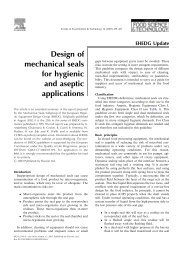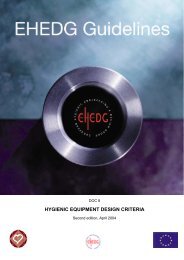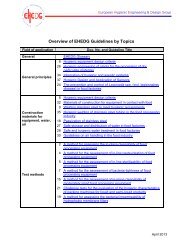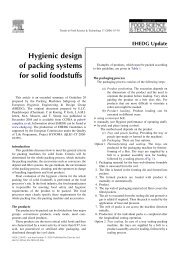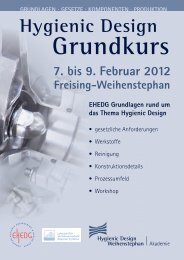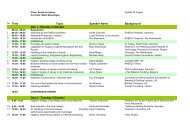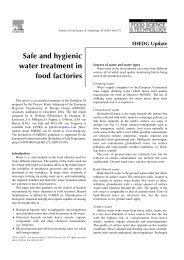Yearbook 2013/2014 - ehedg
Yearbook 2013/2014 - ehedg
Yearbook 2013/2014 - ehedg
You also want an ePaper? Increase the reach of your titles
YUMPU automatically turns print PDFs into web optimized ePapers that Google loves.
78 Effective tank and vessel cleaning: How different systems can help meet today’s demands<br />
Rotating cleaners<br />
Rotating cleaners rotate around an axis, and they can be<br />
found as fast or slowly rotating types (Figures 3 and 4).<br />
Slowly rotating cleaners use flat or round jet nozzles to spray<br />
the cleaning solution on the tank wall. Unlike spray balls,<br />
the cleaner does not wet all inner tank surfaces at the same<br />
time, but rather, applies a concentrated liquid jet to one<br />
segment of the tank wall at a time. This means that the full<br />
impact energy of the jet can act on this particular segment<br />
and that a thicker liquid film forms on the tank wall, which,<br />
due to its higher energy, achieves better cleaning results as<br />
it runs down to the tank outlet. Without switching the supply<br />
pump on/off, this produces a pulse/pause type of operation<br />
for each segment of the tank that allows the product residues<br />
to be softened and rinsed off. This effect cannot be achieved<br />
by a spray ball.<br />
As a result, the mechanical cleaning effect of the slowly<br />
rotating cleaner is much greater than that of a spray ball.<br />
This even applies if the cleaning solution flow rate is relatively<br />
low. Under normal operating conditions the cleaning medium<br />
consumption is about 30-50% less compared to a spray<br />
ball.<br />
Figure 4. Rotating cleaner in the head of a mixing tank.<br />
Figure 3. Various types of rotating cleaners.<br />
Orbital cleaners<br />
The special characterristics of this type of cleaner are the<br />
round-jet nozzles that rotate in two planes and produce<br />
highly focused high impact jets for intensive cleaning of the<br />
inside surfaces of tanks or vessels (Figure 5). Depending on<br />
the type, the cleaners have two or four nozzles. The nozzles<br />
have an inside diameter of up to 12 mm in accordance with<br />
application requirements. The horizontal and vertical rotary<br />
movement is produced by a turbine gear unit, driven by the<br />
cleaning medium, or by a separate drive such as an electric<br />
or pneumatic motor. The continuous rotation in two planes<br />
produces a finely meshed, net-like pattern of cleaning jets<br />
on the inside wall of the tank. At the end of a full cycle, each<br />
and every point of the tank has been directly subjected<br />
to mechanical impact from a strong jet. A complete cycle<br />
typically takes between 3 and 9 minutes. In practice, orbital<br />
cleaners generally operate at pressures of 4 to 8 bar and<br />
can easily cover an effective horizontal cleaning diameter



